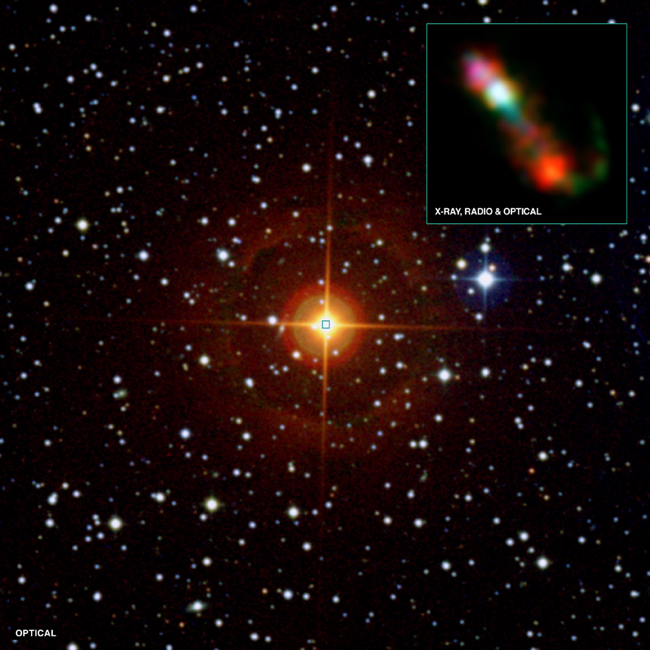
 Credit: X-ray: NASA/CXC/SAO/M.Karovska et al; Optical: NASA/STScI; Radio: NRAO/VLA]; Wide field [Optical (DSS)
Credit: X-ray: NASA/CXC/SAO/M.Karovska et al; Optical: NASA/STScI; Radio: NRAO/VLA]; Wide field [Optical (DSS)
Symbiot
Pairs of stars can interact in many ways beyond the mutual tug of each others' gravity. Symbiotic stars are pairs in which one partner, a white dwarf star, captures and feeds off stellar wind material lost from its companion, a red giant star. Even though a white dwarf is the burnt-out cinder of a star, by capturing the red giant's stellar wind the white dwarf is rejuvenated. When enough material gathers on the surface of the white dwarf, it can erupt with bright emission in the visible and sometimes in X-rays. The image above shows a relatively bright symbiotic star, CH Cygni, in a Palomar Observatory Digitized Sky Survey image. The inset shows a composite multi-wavelength image of CH Cyg: Chandra X-ray data is in red, optical data from the Hubble Space Telescope in green, and radio data from the Very Large Array in blue. This multi-wavelength image reveals a jet of material being powered from the spinning disk of material spiraling onto the white dwarf. The jet is bent, suggesting that the accretion disk around the white dwarf may be wobbling a bit. The formation of jets in these symbiotic systems shares similarities with other jet systems as diverse as pre-main sequence stars and supermassive black holes. These symbiotic systems themselves may evolve into stunning objects: beautiful structured planetary nebulae or supernovae.
Published: June 21, 2010
<
HEA Dictionary ● Archive
● Search HEAPOW
● Other Languages
● HEAPOW on Facebook
● Download all Images
● Education ● HEAD
>

Each week the HEASARC
brings you new, exciting and beautiful images from X-ray and Gamma ray
astronomy. Check back each week and be sure to check out the HEAPOW archive!
Last modified Tuesday, 27-Feb-2024 10:10:01 EST


